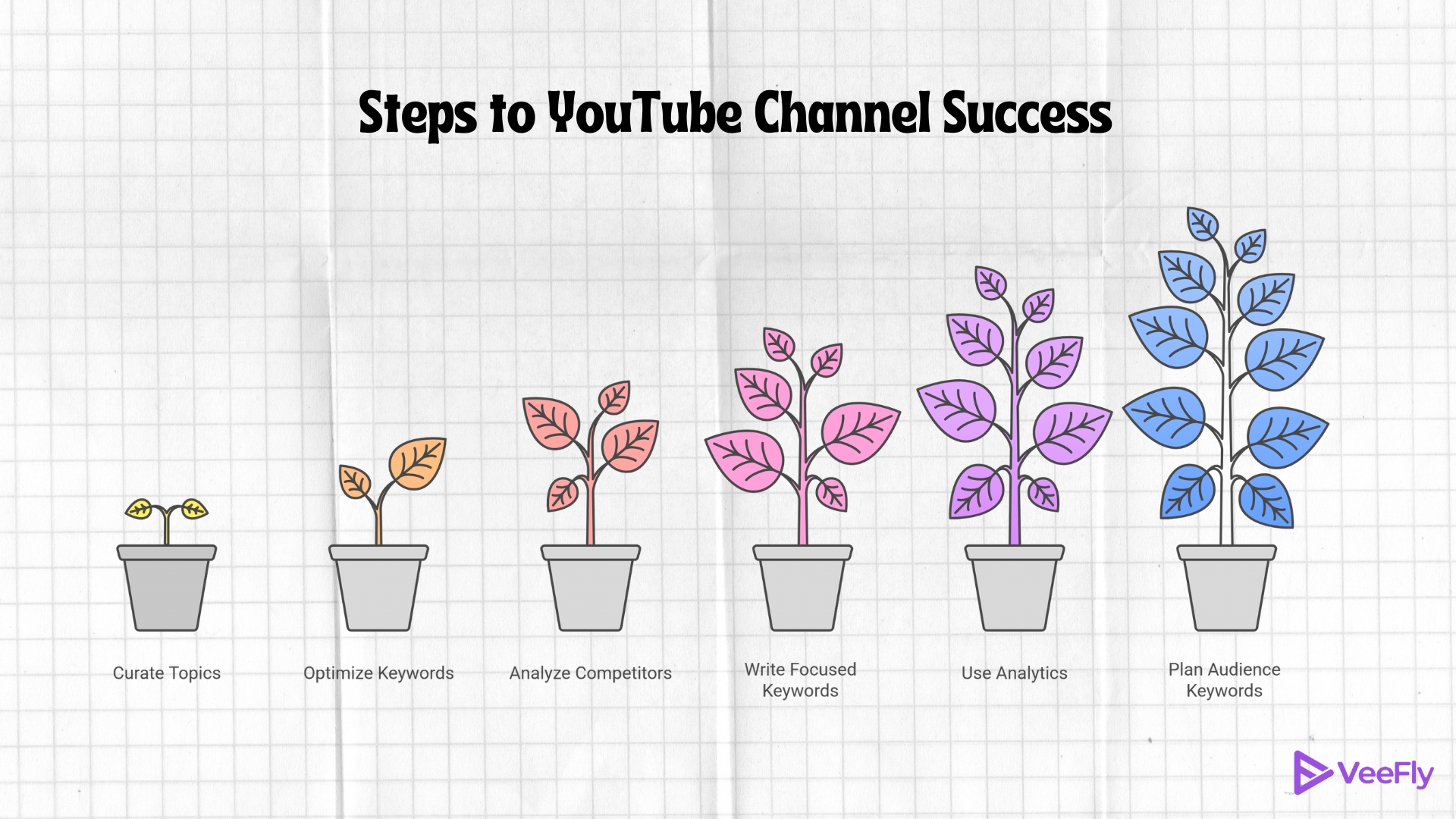YouTube is the most popular video-sharing platform. 500 hours of video are uploaded every minute. You will find die-hard YouTube video watchers who continuously watch and search for videos, from creating a Facebook page to DIY videos and everything in between. As a YouTuber, you aim to share and promote your videos to the maximum audience. Therefore, keywords for YouTube play a vital role in YouTube’s algorithm to help lead viewers to your YouTube channel.
In this post, we will discuss the basics of YouTube keywords, why they are essential, and the best YouTube keyword research tools for helping with the ranking of videos:
What are YouTube Keywords?
Keywords for YouTube are terms and phrases that provide YouTube with information regarding your channel. Based on the information in the description of the YouTube channel and tags, YouTube SEO and its metadata are used to categorize your data, which helps Google index your YouTube videos.
To increase your channel’s subscribers, you will need to optimize its title, tags, and description using proper keyword research.
Using the correct keywords for the YouTube channels is very important to appear at the top of the search result pages because they appeal to viewers. Words such as ‘beginners’ and ‘free’ are usually searched by individuals as much as possible.
Why Are YouTube Channel Keywords Important?
Effective keywords are vital for optimizing your YouTube channel and enhancing its visibility in organic search results. By aligning your channel and video keywords with relevant search queries, the algorithm is more likely to rank your content higher, increasing its exposure. This organic boost helps your videos appear prominently in search results and encourages YouTube to recommend your content to viewers with similar interests.
Using the right keywords builds credibility for your channel and increases the likelihood of your videos being featured in the recommended section. As a result, your channel can attract a genuinely interested audience, leading to growth in subscribers and viewership.
Best Practices for Using YouTube Channel Keywords Optimally
Here are some practical best practices for YouTube channel keywords that can help you organically grow your audience through a well-planned strategy:
Curate Proper Video Topics
The most important thing before starting a YouTube channel is knowing what content you want to make. The platform hosts several niches, offering a variety of options to choose from. Create a detailed list of video topics you wish to produce. It will help in reaching the right audience.
Optimize With Keyword Tools
Choose keywords that are closely related to your channel’s niche. Use keyword research tools and trending videos to find out high-ranking keywords. Leverage tools like Google Keyword Planner, TubeBuddy, or VidIQ to research trending and high-ranking keywords within your niche. Pick keywords that reflect the channel’s goals. A thoughtful keyword selection will help drive organic growth to the channel.
Analyze Niche Competitors
Identifying the channels in your niche that are performing well can help you identify content gaps in your channel. Study the competitor’s video titles, descriptions, and thumbnails. This research will provide valuable insights and help you refine your keyword strategy to stay relevant and competitive.

Write Focused Keywords
As primary keywords and exact phrases are essential, so are long-tail keywords. It will help you strike a balance for your YouTube channel. Using a combination of keywords will maximize the reach of your videos. A broad set of keywords gives your channel the potential to attract a diverse audience. It will boost discoverability and engagement.
Use YouTube Analytics
Analyze your channel analytics to identify which keywords drive traffic and refine your strategy based on data. A periodic update optimizes your channel for search behavior and ensures sustained growth.
Plan Audience Keywords
YouTube keywords tend to change and evolve with changing audience preferences. To maintain the channel’s relevance, regularly revisit your old videos and update the keywords in their titles and descriptions.
Top YouTube Keyword Research Tools
To find keywords on YouTube, you may use various external tools. These tools help creators identify the right keywords for their target audiences to find their content. It includes:
1)VidIQ
VidIQ is popular for finding the best keywords for your YouTube channel, as creators can view average views and utilize a keyword tool to understand their audience better. Further, you can determine whether a video keyword is appropriate by consulting the keyword inspector. You can view the competitor’s tags. Use a keyword generator to translate keywords. Further, it can auto-finish the tag. Use keyword templates.
2)Google Trends
Google Trends can be a goldmine for YouTubers because it is a free tool available at their disposal. Whether you’re a beginner or a seasoned YouTuber, you can effortlessly search for trending topics and keywords with this tool. It will help you discover what viewers are currently searching for, seasonal interest spikes, keyword variations, and trends according to different regions, among other insights.
3)TubeBuddy
It is another popular tool used to search for keywords on YouTube. TubeBuddy is a browser extension and application. The data you need to improve your search results ranking is integrated with your YouTube account. It helps creators to locate high-performance ideas and generate engaging titles using a high-performance keyword search tool.
4)Keywords Everywhere
Keywords Everywhere is a free tool for analysing your channel’s performance. It enables you to conduct advanced analytics using multiple metrics, including traffic sources, subscription data, viewers’ age, gender, cities, and geography.
5)KeywordAPI
Unlike other YouTube keyword research tools, KeywordAPI does not require an account. It extracts high-volume keywords from YouTube’s auto-complete feature to provide creators with ideas for constructing a description, tags, and other relevant metadata. However, with the pro version, you can generate up to 20 keywords for one search term on Google and YouTube. As a result, many SEOs have adopted the keyword tool to find long-tail keywords.
6)Ahrefs
It is a robust tool for finding trending and popular keywords to uncover various video ideas. The research capabilities of this all-in-one SEO tool allow you to locate keywords for different search engines. With Keyword Explorer tools, you can find and filter data based on keyword difficulty, search volume, clicks, etc. So, you can focus on keywords that provide opportunities for your channel. It also enables you to identify the content gaps and the keywords that already rank.
7)Semrush
It is a comprehensive tool for all-around digital visibility planning. Semrush is one of the best keyword research tools, offering in-depth keyword analysis. If you are a YouTuber or a brand marketer, the paid version of the tool can help you with competitive research. It can also instantly help you analyze your competitors’ keywords, including which ones they rank for and the traffic those keywords generate.
8)Google Keyword Planner
Google Keyword Planner helps you improve the YouTube SEO Channel and its algorithm by utilizing keywords, metadata, and other best practices to perform your search better. It also evaluates the benefits of your competition for a specific phrase and all your keywords for your most lucrative SEO strategy. It is an easy-to-use keyword research tool. You can also estimate the monthly search volume for a specific keyword to gauge prospective traffic.
9)YouTube Suggest
YouTube Suggest offers a free program to help you start new channels. The interface is quite simple, and as a content creator, you can access a wealth of valuable insights from the YouTube Suggest. It includes SEO scores, the number of words described, the average viewing time, the number of views, and other relevant metrics.
10)UberSuggest
You can strategically use UberSuggest to boost your viewership and improve YouTube SEO. Combine this with other tools to validate trends using actual search volume, competition, and the overall potential of topics and keywords on YouTube.
How Many Keywords Can You Use On YouTube?
As a general thumb rule, for Keywords for YouTube in each of your meta tags, you should target the following character limits:
- Title of Page: 70 features
- Description of meta – 160 characters
- Metadata – not more than 10 keyword sentences
Keep in mind that overstuffing keywords can hamper your rankings. As a result, you could end up ranking lower.
Conclusion
If you have a new YouTube channel, you would want to look for keywords that are easier to rank. Find the best keywords for YouTube. It will increase the video’s probability of showing up in search engines. First, include your primary keyword and utilize particular, more easily ranked multi-word tags. Include single-word tags and wider-term tags if you have room. Finally, strategically place your keywords in the title, description, and tags. Hence, with an SEO plan in place, your channel can develop and master the YouTube algorithm for your efforts to market your video.
Frequently Asked Questions
Q1. What Are YouTube Tag Keywords?
YouTube tags are descriptive keywords that help your video attract views. It will also make it easier for viewers to find and engage with your content.
Q2. How to find viral tags for YouTube?
To find viral tags for YouTube, look at the high-performing tags in your niche that your competitors are using. Additionally, search for low-competition keywords with high search volume to increase viewership.
Q3. How Many Keywords Are Good For YouTube?
A YouTube video should have a maximum of 5-7 keywords. The idea is to avoid cluttering the description box with keywords or hashtags.
Q4. How to find high cpm keywords for YouTube?
To find high CPM (Cost per mile) Keywords, search for keywords that are highly relevant to your niche and have a higher search volume.
Q5. What Is the Difference Between Tags & Keywords?
Tags and keywords are the same. However, the significant difference is that viewers see tags, whereas keywords are hidden and only seen by crawlers and algorithms for SEO purposes.
Q6. How often should I update my keyword strategy?
Update your keyword strategy every quarter or if you notice some changes in trends or audience behavior.
Summary
- YouTube is the most popular video-sharing platform with 500 hours of video uploaded every minute.
- Keywords are crucial for optimizing YouTube channels, enhancing visibility in search results, and attracting a relevant audience.
- Best practices for using YouTube keywords include choosing keywords strategically, analyzing competitors, and using a mix of broad and specific keywords.


